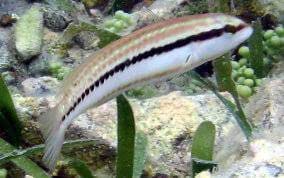Home › Sea Life › Marine Animals › Vertebrates › Wrasse › Slippery Dick
Fun Facts about Slippery Dick Wrasses
[Phylum: Chordata] [Class: Actinopterygii] [Order: Labriformes (ray-finned)] [Genus: Halichoeres]
At first glance, this slippery fish looks like most of the wrasse species, small and lithe. But when it's fully grown, it measures about nine inches long (23 centimetres).
This guide contains fun facts and information about slippery dick wrasses (Halichoeres bivittatus), including where they live, what they eat, and how they reproduce.
Slippery Dick Fish Distribution and Habitat
These small wrasses flourish in the shallow reefs near Bermuda all the way down to Brazil (e.g. the western Atlantic Ocean).
So, search through the seagrass beds of other tropical and subtropical waters, and you can also find them in places like:
- The Caribbean Sea
- North Carolina
- The Gulf of Mexico
Most of the 500 species of wrasse fish inhabit the rocky shorelines and sandy sea beds of temperate marine habitats around the world. But, being mostly reef-associated means it's rarely seen at depths deeper than fifteen (15) metres (49 feet).
What Do Slippery Dicks Look Like?
Unlike the colossal Asian sheepshead wrasse, the slippery dick fish is quite small in comparison. So much so, even a full grown adult is unlikely to be more than thirty centimetres long or weigh more than 150 grams (5 ounces).
Here's the thing:
Their body shape is thin and elongated, like a cigar. Having a terminal mouth means it's a mid-water feeder. There are three distinct phases that affect the colouration and markings during the fish's lifespan:
- The background body colouring is mostly white throughout the juvenile phase and their scales are slimy. Two dark stripes run from the pectoral fins to the tail.
- Then, juveniles become females during the initial phase. There's little change in the body coloration, but they often develop some pink shading.
- These fish become males in the terminal phase, when the background coloration changes to green. There will be more pink lines on the head and tail with small black dots.
Pro Tip: You may be wondering how the slippery dick wrasse got its name? In fact, we have a comprehensive list of weird and funny fish names with explanations behind the common and scientific classifications.
Slippery Dick Wrasse Diet
Slippery dicks are typical carnivores that also engage in the 'following behaviour'. Thus, they will 'shadow' other benthic fishes, such as goatfishes, to feed on any leftover scraps. In fact, the diet of most wrasses will include an assortment of benthic invertebrates, such as:
 Brittle stars
Brittle stars- Crab species
- Gastropods (slugs and snails)
- Ophiuroids
- Sea urchins
- Segmented worms (polychaetes)
- Small fry
Halichoeres Bivittatus Reproductive Process
The formation of a male and female pair needs to occur before the spawning process can go ahead. This is when scuba divers may see 'lek mating in fishes', as the males perform their courtship displays.
Even though they are oviparous fish, they are also protogynous and sequential hermaphrodites. Thus, all wrasses will be born as a female and some will change their gender to become a male to start the breeding process.
But wait - there's more:
They spend a lot of time around rocky coral reefs during the gestation period. Even though gestation may last for several months, this is where they will eventually release the fertilised eggs. In most cases, the eggs will hatch a few days after spawning.
Threats and Natural Predators
Apart from the detrimental effects of human behaviour, such as marine pollution and habitat erosion, slippery dick wrasses are widespread.
Put another way, the International Union for Conservation of Nature (IUCN) lists slippery dick wrasse (Halichoeres bivittatus) as being of 'Least Concern'.
Related Information and Help Guides
- Broomtail Wrasse Facts and Information with Pictures
- Everything You Need to Know about Slingjaw Wrasse
- Fun Facts and Information about Asian Sheepshead Wrasse
- Wrasses Facts and Species Information with Video
Note: The short video [1:41 seconds] presented by UnderWater Exploring contains interesting footage about a slippery fish species with a naughty name.